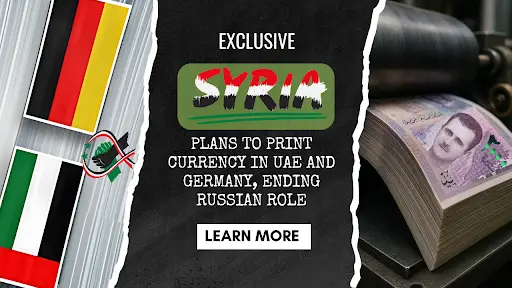
For over a decade, Syria has relied on Russia to print its currency. This arrangement began after Western sanctions, imposed in response to the Syrian civil war, cut off access to European currency printers.
Now, Syria is shifting its currency printing operations to the United Arab Emirates (UAE) and Germany. This move reflects Syria’s efforts to rebuild its economy and establish new international partnerships following years of conflict and economic sanctions.
After the Syrian war began in 2011, the country faced big problems with money printing. Sanctions from the West blocked Syria from using its usual European printing services. To solve this, Syria started printing its money in Russia. This solution helped in the short term but created new problems over time. Many people inside and outside Syria began to question the quality, trust, and control over the currency.
The new notes were not always high quality, and fake notes started to appear. People began to lose trust in the Syrian Pound. Many Syrians also felt uncomfortable relying on another country for their own currency. Some regional neighbors viewed Syria’s money as weak or unstable because of its connection to Russia. This damaged both local and international trust in the currency.
Syria is now planning to print its new currency in the United Arab Emirates and Germany. This marks a major change in policy. For more than a decade, Syria depended on Russia to print money. Now, the country wants to move away from that arrangement. The shift to Germany and the UAE shows that Syria is trying to improve its currency quality, reduce outside control, and rebuild trust in the Syrian Pound.
The UAE is also building its reputation in this field. Its printing facilities are modern, and the country is becoming a growing center for finance and innovation in the region.
Syria sees this change as a way to produce stronger and more secure banknotes. Many Syrians have complained about poor-quality notes that tear easily or are easy to copy. By printing in Germany and the UAE, Syria hopes to introduce new, durable designs that are harder to fake and easier to trust.
Choosing the UAE and Germany sends a clear message: Syria is opening up and trying to balance its foreign ties. This move could help improve relations with both Gulf countries and Western nations.
In early 2025, the European Union and the United States eased some of their sanctions on Syria. This has made it easier for Syria to look beyond Russia and work with new partners.
One major sign of stronger ties is Syria’s recent agreement with DP World, a major UAE company. In that deal, worth $800 million, DP World will help develop the port in Tartus. This shows that economic cooperation between Syria and the UAE is growing stronger. Printing currency in the UAE is another step in that direction.
Printing new banknotes is not only about replacing old money. It is also about improving the safety and quality of the currency. Syria has struggled with poor-quality banknotes for years. Now, with plans to print money in the UAE and Germany, the country is hoping to fix many of these problems.
Syria’s choice to print its money in the UAE and Germany is not just a financial decision. It also carries major political and economic meaning. This shift reflects deeper changes in Syria’s international relationships and future goals.
Independence from Russia: Ending reliance on Russian currency printing is a clear political statement, asserting greater independence and signaling a shift in Syria’s alliances. Involving Germany and the UAE in currency production could pave the way for broader financial and economic cooperation, including investment and technical assistance.
Potential for New Collaborations: While Russia may seek to retain influence through its military presence and other interests in Syria, this move could provoke diplomatic or economic pushback. However, printing currency in respected global centers enhances Syria’s monetary credibility and may help rebuild trust with Western and Gulf partners, positioning currency production as a tool of soft power and sovereignty.
Syria’s decision to print new banknotes in the UAE and Germany comes with financial and logistical challenges. For the transition to succeed, careful planning and strong oversight will be needed.
Syria’s plan to print its currency in the UAE and Germany marks a significant step toward economic recovery and international reintegration. Beyond the technical aspects of banknote production, this move reflects a bold reorientation of economic alliances, a bid for greater sovereignty, and an effort to restore public trust in the national currency.
If managed prudently, it could lay the groundwork for deeper international engagement and a more credible, stable monetary future.
End